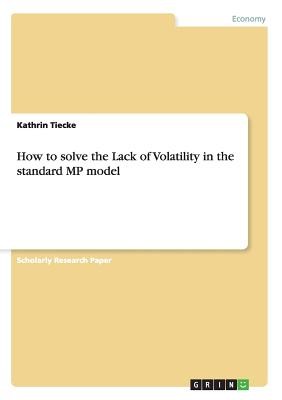
- We will send in 10–14 business days.
- Author: Kathrin Tiecke
- Publisher: GRIN Verlag
- ISBN-10: 3640801032
- ISBN-13: 9783640801039
- Format: 14.8 x 21 x 0.2 cm, softcover
- Language: English
- SAVE -10% with code: EXTRA
How to solve the Lack of Volatility in the standard MP model (e-book) (used book) | bookbook.eu
Reviews
Description
Research Paper (undergraduate) from the year 2009 in the subject Economics - Macro-economics, general, grade: 2,3, Humboldt-University of Berlin (Wirtschaftstheorie II (Makro)), course: Arbeitsmarktökonomik, language: English, abstract: The standard search and matching model (D. Mortensen and C.Pissarides,1994; Pissarides, 2000) has been recently challanged by many economists. The Mortensen-Pissarides (1994) model in general says that it takes time to match jobs and workers, which causes unemployment as an outcome of market frictions. The volatility of unemployment fluctuations in the model is not corresponding to the baseline calibration that R. Shimer (2005) has found for the US data. Many authors modified the model in order to solve this lack of volatility. First I introduce the Mortensen-Pissarides model to refer in the second part to the models parameters. Next, I present solutions found by Hall (2005) who solves the model via rigid wage setting and Hagedorn and Manovskii(2005) who provide a small surplus calibration to overcome the lack in volatility of the labor market variables. According to the so called "Shimer Puzzle" I will present shortly the findings of Gartner, Merkl and Rothe (2009), who calibrate the key labor market variables over the business cycle for the West-German labor market. Further I introduce Morensen and Nagypál (2007) publications on an amneded version of the model and a model with endogenous separations.
EXTRA 10 % discount with code: EXTRA
The promotion ends in 16d.21:14:31
The discount code is valid when purchasing from 10 €. Discounts do not stack.
- Author: Kathrin Tiecke
- Publisher: GRIN Verlag
- ISBN-10: 3640801032
- ISBN-13: 9783640801039
- Format: 14.8 x 21 x 0.2 cm, softcover
- Language: English English
Research Paper (undergraduate) from the year 2009 in the subject Economics - Macro-economics, general, grade: 2,3, Humboldt-University of Berlin (Wirtschaftstheorie II (Makro)), course: Arbeitsmarktökonomik, language: English, abstract: The standard search and matching model (D. Mortensen and C.Pissarides,1994; Pissarides, 2000) has been recently challanged by many economists. The Mortensen-Pissarides (1994) model in general says that it takes time to match jobs and workers, which causes unemployment as an outcome of market frictions. The volatility of unemployment fluctuations in the model is not corresponding to the baseline calibration that R. Shimer (2005) has found for the US data. Many authors modified the model in order to solve this lack of volatility. First I introduce the Mortensen-Pissarides model to refer in the second part to the models parameters. Next, I present solutions found by Hall (2005) who solves the model via rigid wage setting and Hagedorn and Manovskii(2005) who provide a small surplus calibration to overcome the lack in volatility of the labor market variables. According to the so called "Shimer Puzzle" I will present shortly the findings of Gartner, Merkl and Rothe (2009), who calibrate the key labor market variables over the business cycle for the West-German labor market. Further I introduce Morensen and Nagypál (2007) publications on an amneded version of the model and a model with endogenous separations.


Reviews